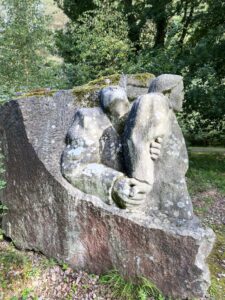
How high did the water rise? Did it lap at the toes of those who had found life-saving height on handy rocky shelves? Did it embrace waists, the cold fingers of a no-longer-desired lover tugging at drenched trousers? Or did it soak through heavy flannelled shirts to turn arms and shoulders into numbed sponges?
I’d followed the guide book’s instructed way along an old ‘dram’ road which had once filled the narrow valley floor. Pocked, rectangular stones part-buried in the reddish clay and tufted grass confirmed my path. Beating aside nettles and brambles, I imagined away the overgrown greenery and pictured instead bare soil, scarred rocks, and gouges in the earth which turned to streaming rivulets after rain. If I listened hard on the still air, I was sure I would hear the ghosted cries of men and the heavy breaths of horses at their sweaty toil.
The dog nosed along behind, sniffing out long-buried odours.
At the end of the dram road, a plaque on a stone revealed the raw facts: water from abandoned mine workings flooding through the tunnels; seven men trapped; five days before rescuers reached them; four dead.
What did they speak of through their eternal black wait? Hope, surely – ‘Don’t give up, owld butt … summat’ll happen, doan thee worry now.’ Of hunger? Or did the exhaustion of keeping upright against the turgid sucking pull drive away hunger? Did they drink the greasy water, thickened like broth with dirt and coal dust? The water which was both life-giver and life-taker.
I closed my eyes against the bright sun, understanding I would never, even in the darkest reaches of a moonless, starless night, be able to simulate the black, wet horror of that flooded tunnel. I took a deep breath, shook my head and opened my eyes to look at the statue sitting above the plaque.
Two men, larger than life. Only their upper bodies are sculpted, legs buried in rock as cold and unforgiving as a shroud. It’s a monument to death, and to a fierce compassion. One miner faces outwards, stolid, his eyes blank, his mouth downturned as he bears the weight of the other who clings to him. This one’s head is thrown back in surrender to the flood. He’s near death, and he’s dragging his brother down – for I thought of them as the two brothers among those taken lifeless from the black waters. Thomas and Amos, their arms entwined and their hands clasped, both carried into forgetfulness by this new Lethe.
The dog, bored with the inaction, nudged my leg. I turned away, back to the dram road and my sunlit hike up the slade.
(More stories can be found here. )